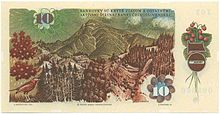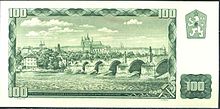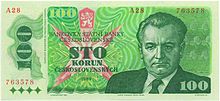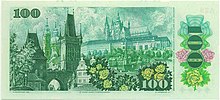Czechoslovak crown

The Czechoslovak krona ( koruna československá and koruna česko-slovenská in Czech and Slovak ) was the official currency of Czechoslovakia until December 31, 1992, and the currency of the Czech Republic and Slovakia until February 7, 1993 .
Successor and predecessor
The currency unit in Austria-Hungary until 1918 (abbreviated K), as well as from 1993 in Slovakia and the Czech Republic , were or are also referred to as the "krone". The currency of the First Slovak Republic (1939–1945) and the currency of the Protectorate of Bohemia and Moravia also had this name (abbreviated as Ks and K).
Smaller units
Each Czechoslovak crown was equivalent to 100 Hellern ( Slovak : halier , Czech : haléř ; plural: halierov or haléřů ) and the abbreviation in Slovakia is “hal” and “h” in the Czech Republic.
Spelling
The abbreviation of the currency was Kčs (until 31 October 1945 Kč ), the official ISO 4217 code was CSK . CSK comes from česko-slovenská koruna and CZK stands for the Czech crown .
As in German-speaking countries, currency abbreviations are written after the face value in the Czech and Slovak languages (for example: 100,000 Kčs / 100,000 Sk / 100,000 SKK / 100 hal).
history
The krona was introduced in Austria-Hungary on September 11, 1892 as the first gold-based currency in this area ( Austrian krona ). After the establishment of Czechoslovakia in 1918, a new currency system had to be created quickly, which differed from the inflation-prone currencies of the other newly created countries. For the time being, however, the banknotes and coins of the Austro-Hungarian bank were still valid on the territory of the young state.
"The preparation for currency separation was done in complete secrecy and on the basis of the Enabling Act of February 25, 1919 Coll. Ges. And Bdg. No. 84, the cancellation of all circulating banknotes of the Austro-Hungarian bank was ordered on March 19, 1919. By the cancellation ... had (they) become Czechoslovakian money and the Ministry of Finance gradually withdrew these notes and exchanged them for Czechoslovak state notes. " (Quote from source Walter Simon)

Such a currency reform took place, with which the Czechoslovak crown was created. ( Československá koruna , Kč / later Kčs). The first banknotes came into circulation in the same year, followed by the first own coins in 1922, which replaced the previously valid Austro-Hungarian base denominations. The old gold and silver crowns had practically disappeared from circulation since the war.
The kroon currency was subject to several reforms and changes in the further course. So was z. For example, the law of November 7, 1929 stipulated the gold content at 44.85 mg per 1 Kč in commercial trade ("gold core currency"). In the period from 1923 to around 1929, the krona was relatively stable in value, fluctuating on average between 15.36 and 16.37 Swiss francs per 100 kroner. The exchange rate against the Reichsmark was 0.85 in 1932.
In the wake of the Great Depression (1929), which hit Czechoslovakia particularly hard, the krona began to decline dramatically. The country experienced the greatest slump in the spring of 1933, when other European countries had already bottomed out. The industrial production index fell below 60 percent of its pre-crisis level. Even in 1937 the consequences could still be felt. The krona was clearly devalued, which opened the door to world markets somewhat.
This was followed by an inflationary period during the Second World War - when the crown split into the Slovakian and the German protectorate of the occupation of Bohemia and Moravia. A rather radical reform then took place in 1953. At that time, the Communist Party of Czechoslovakia was grappling with the problem of the double market for goods: on the one hand there was a fixed-price market for basic foodstuffs - a holdover from the post-war quota system, on the other hand a free market for goods were up to 8 times more expensive, but also of better quality. It was decided to carry out the currency reform on June 1, 1953 and to distribute new banknotes that had been printed in the USSR . The reform was prepared in a very short period of time and should be kept secret until the last minute, however information about an imminent reform became public and panic reactions occurred among the population. The night before the introduction, Czechoslovak President Antonín Zápotocký made a televised address in which he denied any possibility of currency reform and tried to reassure the population, even though he knew he was lying to the nation. The next day, people (who were lucky enough not to fall into the “capitalist element” category) were allowed money worth up to 300 new kroner (at the ratio of 5 old kroner to 1 new kroner) and the rest at a rate of 50: 1 exchange. All insurance stocks, government bonds and other securities have been declared worthless. Many people's economic situation deteriorated dramatically; riots and demonstrations broke out in many places, for example in Pilsen , where 472 people were arrested.
The parliaments of the Czech Republic and Slovakia passed the relevant currency segregation laws in early February 1993, and on February 8, 1993, following the dissolution of the Czechoslovak Federation, the Czechoslovak crown split into two independent currencies - the Slovak crown and the Czech crown . Initially, however, the banknotes of the Czechoslovak crown were still used, which since August 2, 1993 have been differentiated by first glued and then printed stamps. Since Slovakia joined the Eurozone on January 1, 2009, the Slovak crown has been history.
Coins
1, 2, 3, 5, 10, 20, 25 and 50 Heller pieces were minted, as well as 1, 2, 3, 5 and 10 Kronen pieces. Commemorative silver coins of 20, 25, 50, 100 and 500 crowns were also minted.
Banknotes from 1953
| Surname | value | Banknote in front | Banknote on the back | size | validity | Issue from |
|---|---|---|---|---|---|---|
| A Czechoslovak crown | 1 Kčs | 101 × 51 mm | 06/01/1953 - 05/31/1960 | 1953 | ||
| Three Czechoslovak crowns | 3 Kčs | 110 × 56 mm | 06/01/1953 - 12/31/1972 | 1953 | ||
| Three Czechoslovak crowns | 3 Kčs | 113 × 56 mm | December 01, 1961 - December 31, 1972 | 1961 | ||
| Five Czechoslovak crowns | 5 Kčs | 120 × 61 mm | 06/01/1953 - 12/31/1972 | 1953 | ||
| Five Czechoslovak crowns | 5 Kčs | 123 × 60 mm | December 01, 1961 - December 31, 1972 | 1961 | ||
| Ten Czechoslovak crowns | 10 Kčs | 129 × 65 mm | 06/01/1953 - 12/31/1963 | 1953 | ||
| Ten Czechoslovak crowns | 10 Kčs | 133 × 65 mm | 02/01/1961 - 06/30/1988 | 1960 | ||
| Ten Czechoslovak crowns | 10 Kčs | 132 × 67 mm | 07/01/1986 - 07/31/1993 | 1986 | ||
| Twenty Czechoslovak crowns | 20 Kčs | 132 × 58 mm | 04/01/1971 - 06/30/1991 | 1970 | ||
| Twenty Czechoslovak crowns | 20 Kčs | 137 × 67 mm | October 1, 1988 - July 31, 1993 | 1988 | ||
| Twenty-five Czechoslovak crowns | 25 Kčs | 140 × 69 mm | May 2, 1962 - December 31, 1972 | 1961 | ||
| Fifty Czechoslovak crowns | 50 CZK | 150 × 74 mm | 04/01/1965 - 06/30/1991 | 1964 | ||
| Fifty Czechoslovak crowns | 50 CZK | 142 × 67 mm | October 01, 1987 - July 31, 1993 | 1987 | ||
| One hundred Czechoslovak crowns | 100 Kčs | 164 × 80 mm | 12/01/1962 - 02/07/1993 | 1961 | ||
| One hundred Czechoslovak crowns | 100 Kčs | 147 × 67 mm | October 1, 1989 - December 31, 1990 | 1989 | ||
| Five hundred Czechoslovak crowns | 500 CZK | 157 × 67 mm | 11/01/1973 - 02/07/1993 | 1973 | ||
| A thousand Czechoslovak crowns | 1000 CZK | 157 × 67 mm | 10/01/1985 - 02/07/1993 | 1985 |
swell
- Walter Simon: The financial economy in the Czechoslovak Republic , German association for non-profit knowledge in Prague, July – September 1930, No. 617–19.
- Günter Graichen: The money tokens of Czechoslovakia , transpress publishing house for transport Berlin 1983, 1st edition.
Individual evidence
- ↑ see: List of exchange rates (gold standard)
- ↑ From AZ: Das Konversationslexikon; Berlin 1932, Col. 417ff
- ↑ The Great Depression of the 1930s - Czechoslovakia was hit particularly hard Radio Praha International from October 17, 2009, accessed on May 22, 2020.
- ↑ PDF at www.thecurrencycollector.com
- ↑ Florian Schön: Coin catalog for the Czech Republic and Czechoslovakia , 2015


























